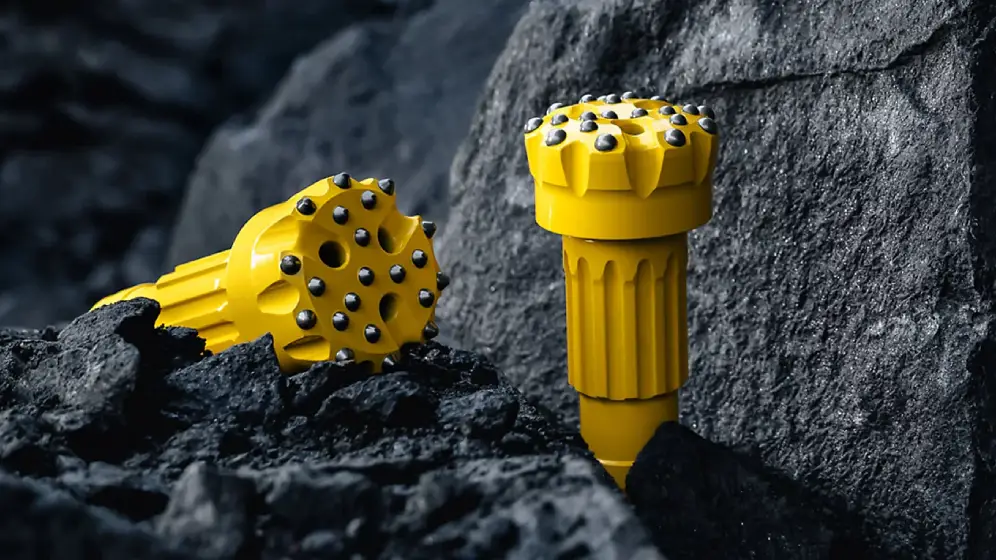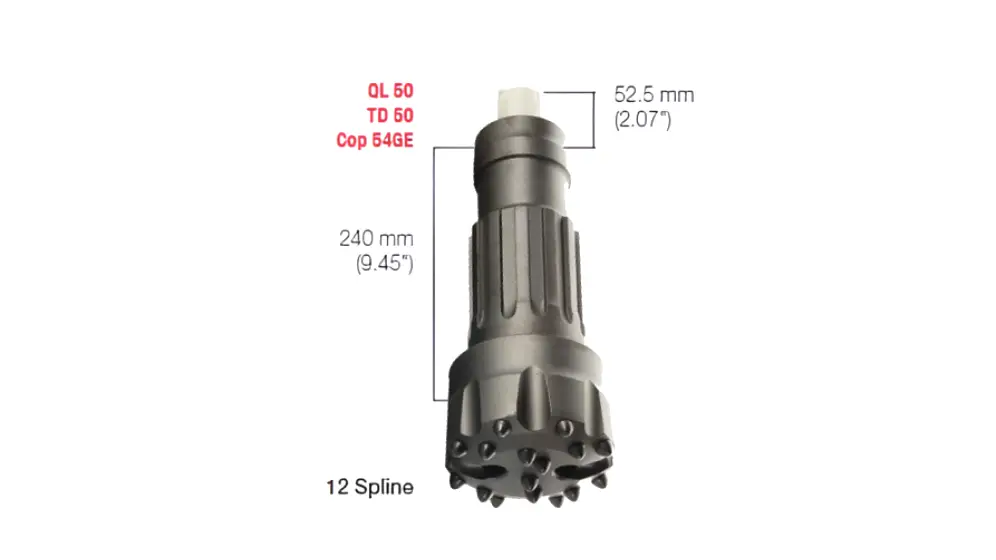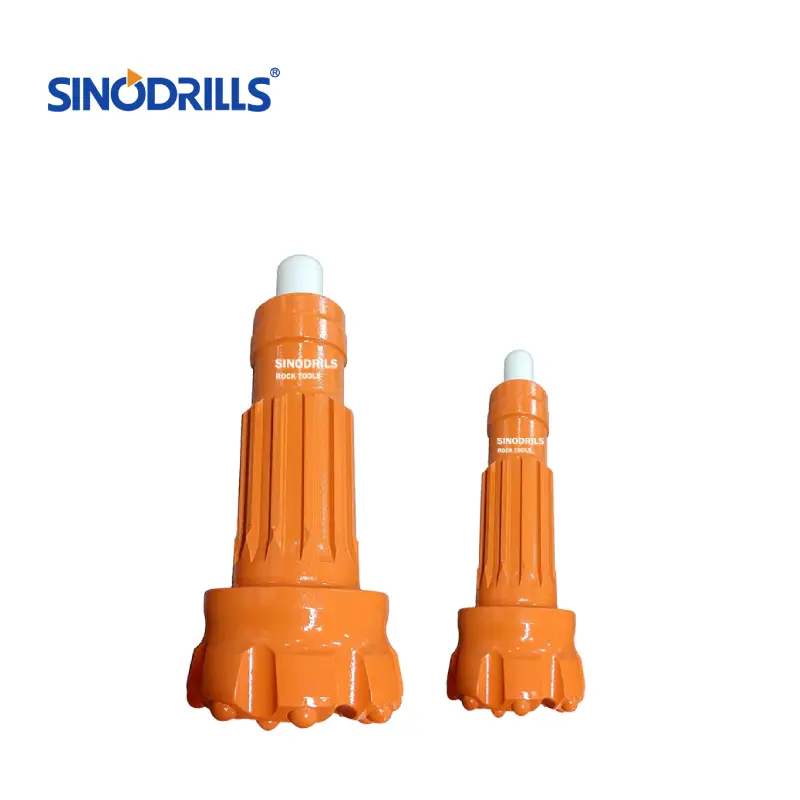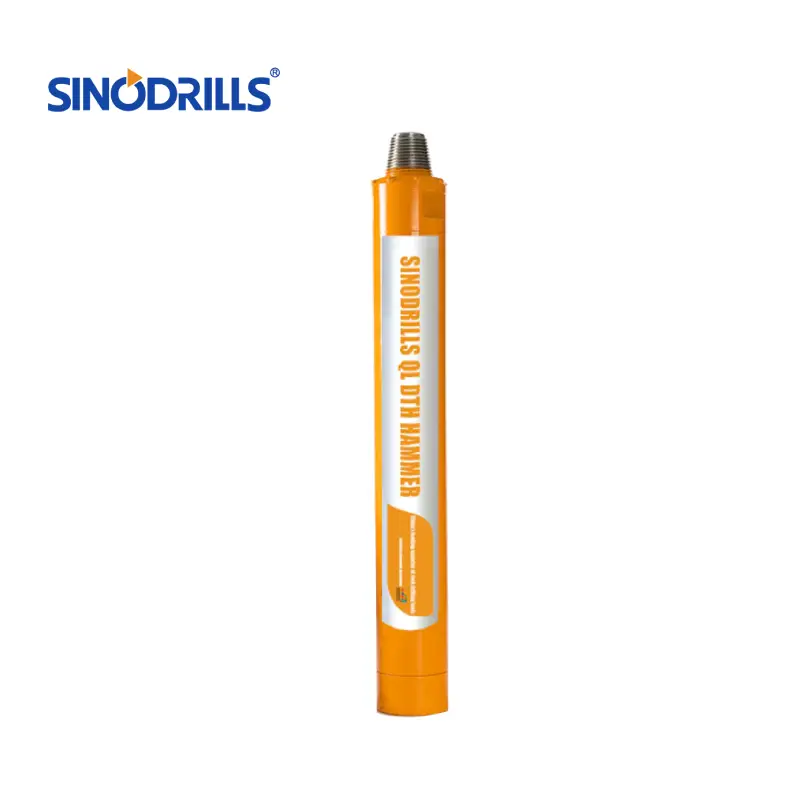When tackling the toughest geological challenges, the choice of drilling equipment is paramount. In the world of Down-The-Hole (DTH) drilling, QL drill bits have emerged as a preferred solution, particularly when confronting hard rock environments.
This blog delves into the specific applications and inherent advantages that make QL drill bits the go-to choice for mining, quarrying, and construction projects where durability and efficiency in abrasive rock are non-negotiable.
What is a DTH Drill Bit?

What is QL button bits for DTH hammer?
A DTH (Down-The-Hole) drill bit is a specialized cutting tool used in percussive drilling, primarily for breaking through rock and other hard geological formations. Unlike conventional rotary drill bits, a DTH drill bit works in conjunction with a DTH hammer, which is located directly above the bit within the borehole.
The hammer delivers rapid, powerful impacts directly to the back of the drill bit, while the drill string simultaneously rotates the bit to ensure fresh rock is exposed for each impact. Made from high-grade alloy steel and fitted with durable tungsten carbide buttons, DTH drill bits come in various designs (face shapes, button configurations) and shank types to optimize performance across different rock types and drilling applications in mining, quarrying, construction, and water well drilling.
What Does QL Mean in DTH
In DTH (Down-The-Hole) drilling, QL refers to a specific and widely used shank type or series of DTH hammers and their compatible drill bits.
While not a direct acronym, it’s often associated with “Quantum Leap” or “Quick Link,” reflecting its design for high performance and efficient connection. QL bits are known for their robust build and effectiveness in hard rock applications across various industries.
QL Drill Bit Applications
QL DTH drill bits are renowned for their robust performance and efficiency, making them indispensable across a spectrum of demanding drilling operations. Their design ensures optimal energy transfer and exceptional durability, particularly in challenging geological conditions. This makes them a preferred choice for professionals seeking reliable and high-yield solutions.
The versatility of QL drill bits allows them to excel in diverse environments, from massive open-pit mines to intricate construction sites. Their adaptability to various rock types and drilling requirements underscores their critical role in modern drilling technology.
Mining Operations
In the mining industry, QL drill bits are fundamental for creating blast holes in both open-pit and underground mines. Their ability to penetrate extremely hard and abrasive rock formations with high efficiency significantly contributes to optimized blasting patterns and increased ore extraction rates. The robust construction ensures long service life, minimizing downtime for bit changes and enhancing overall operational productivity.
Beyond blast holes, QL bits are also crucial for production drilling and auxiliary tasks like pre-splitting and dewatering. Their precision and power enable miners to achieve desired hole straightness and depth, which is vital for safe and efficient blasting, ultimately impacting the economic viability of mining projects.
Quarrying
Quarrying operations rely heavily on efficient drilling for rock extraction used in aggregates, dimension stone, and cement production. QL drill bits are a go-to choice due to their superior penetration rates and wear resistance in challenging quarry environments. They effectively break through various types of rock, ensuring consistent fragmentation for processing.
The durability of QL bits means fewer bit replacements and reduced operational costs, a significant advantage in the high-volume nature of quarrying. Their consistent performance in diverse geological conditions found in quarries contributes to a steady supply of raw materials and maintains production schedules.
Construction Projects
For large-scale construction, QL drill bits are indispensable in tasks such as foundation drilling, road cutting, and tunneling. They efficiently drill through hard rock for anchor points, piling, and creating pathways, ensuring structural integrity and project timelines are met. Their precision helps in creating accurately sized holes for various construction elements.
In urban and infrastructure development, where encountering varied and often tough ground conditions is common, QL bits provide the necessary power and reliability. Their ability to perform consistently in diverse rock types makes them a vital tool for engineers and contractors aiming for efficient and safe project completion.
Water Well Drilling
When drilling water wells, particularly in regions with hard bedrock, QL drill bits are highly effective. Their powerful percussive action allows for rapid penetration through dense rock layers, reaching aquifers quickly and efficiently. This speed is crucial for timely water access in agricultural, industrial, and residential applications.
The reliability and robustness of QL bits ensure that well drillers can achieve target depths with minimal complications, even in challenging geological formations. Their consistent performance helps in creating stable and productive water wells, providing essential resources to communities and industries.
Geothermal Drilling
Geothermal drilling involves reaching deep, hot rock formations to harness Earth’s internal heat for energy production. QL drill bits are preferred in these applications due to their exceptional durability and penetration capabilities in extremely hard and often hot rock. They can withstand the demanding conditions associated with deep drilling.
The efficiency of QL bits in these high-temperature, high-pressure environments is critical for the economic viability of geothermal projects. Their ability to maintain performance over long drilling intervals reduces the need for frequent bit changes, accelerating project timelines and contributing to the development of sustainable energy sources.
QL Drill Bit Sizes

QL DTH drill bits are available in a wide range of sizes, designed to match the specific QL series DTH hammer they pair with and the desired borehole diameter.
The “QL” designation (e.g., QL40, QL50, QL60, QL80) broadly indicates the hammer and bit’s class, often correlating with the nominal hammer size in inches or the general range of hole diameters it can efficiently drill. This ensures optimal energy transfer from the hammer’s piston to the rock-breaking face of the bit.
Manufacturers like Sandvik, Halco, GMD Equipment, and many others produce QL series bits to cater to various drilling needs. The exact bit diameter for each QL series can vary slightly between manufacturers and depend on specific bit face designs (e.g., flat, convex, concave) and button configurations. However, they generally fall within established ranges to maintain compatibility with the corresponding QL hammer.
Here’s a general overview of common QL drill bit sizes and their typical corresponding hammer sizes:
QL40:
Designed for 4-inch DTH hammers. Typical bit diameters range from 105mm (4 1/8″) to 130mm (5 1/8″).
QL50:
Designed for 5-inch DTH hammers. Typical bit diameters range from 130mm (5 1/8″) to 165mm (6 1/2″).
QL60:
Designed for 6-inch DTH hammers. Typical bit diameters range from 152mm (6″) to 203mm (8″).
QL80:
Designed for 8-inch DTH hammers. Typical bit diameters range from 200mm (7 7/8″) to 279mm (11″).
Common QL Drill Bit Sizes
| QL Shank Type | Typical Hammer Size (inches) | Common Bit Diameter Range (mm) | Common Bit Diameter Range (inches) |
| QL40 | 4″ | 105mm – 130mm | 4 1/8″ – 5 1/8″ |
| QL50 | 5″ | 130mm – 165mm | 5 1/8″ – 6 1/2″ |
| QL60 | 6″ | 152mm – 203mm | 6″ – 8″ |
| QL80 | 8″ | 200mm – 279mm | 7 7/8″ – 11″ |
Note: These ranges are approximate and can vary slightly between manufacturers and specific bit designs (e.g., face profile, button count).
How to Choose Right QL Drill Bits
Choosing the right QL drill bit is crucial for optimizing drilling performance and cost-efficiency. Several factors must be considered to match the bit to your specific drilling conditions and desired outcomes, ensuring maximum penetration and bit life.
Rock Hardness and Abrasiveness:
- Hard Rock: For very hard and abrasive rock (like granite or quartzite), select bits with a flat face or convex face and hemispherical carbide buttons. These designs offer superior wear resistance and durability, effectively handling the tough conditions and prolonged impact.
- Medium-Hard Rock: For medium-hard, less abrasive rock (such as limestone or sandstone), a drop center or concave face with ballistic buttons can provide faster penetration rates, balancing aggressiveness with wear.
Drilling Application:
- Blast Hole Drilling: Focus on high penetration rates and hole straightness. Bits with a flat face and robust buttons are often preferred, ensuring uniform breakage for effective blasting operations in mining and quarrying, optimizing explosive use.
- Water Well/Geothermal Drilling: Prioritize durability and hole integrity over long drilling intervals. Convex or flat face bits with tough hemispherical buttons are suitable, as they maintain gauge and resist wear in deep, continuous drilling.
Desired Hole Straightness:
- Straight Holes: For applications requiring high precision like pre-splitting or long anchor holes, a flat face or double gauge design helps maintain better hole straightness. These designs minimize deviation by providing stability against the borehole walls.
- Less Critical Straightness: In applications where slight deviation is acceptable, convex or concave face bits might be chosen for their faster penetration, balancing speed with the specific requirements of the project.
Air Pressure and Hammer Type:
- High Air Pressure: Modern QL hammers operating at high air pressures (25-35 bar) benefit from bits designed to withstand increased impact energy. These bits feature stronger bit bodies and more robust carbide inserts, maximizing the hammer’s powerful blows and ensuring efficient rock breaking.
- Lower Air Pressure: For older or lower pressure hammers, selecting bits optimized for efficient energy transfer at lower impact forces is important. These bits are designed to still achieve good penetration even with less powerful percussive action.
Cost-Efficiency and Bit Life:
While higher-priced bits often offer superior performance and longevity, evaluate the cost per meter drilled rather than just the initial purchase price. A more expensive bit that lasts significantly longer and drills faster can be more economical in the long run, reducing overall operational costs.
Conclusion
We have explored how QL drill bits are indispensable tools for overcoming the challenges of hard rock environments. We now recognize their superior design and robust construction which translates directly into better performance and lower operational costs for your mining and quarrying projects. We manufacture these bits to provide exceptional impact energy transfer and maintain a high rate of penetration (ROP), ultimately maximizing your productivity on the job site.
We offer QL drill bits with precision-engineered carbide inserts and hardened steel bodies that guarantee longer service life and reduced need for replacements. This durability is not just a feature; it’s a promise of greater reliability and efficiency for your entire drilling program. We are committed to supplying tools that will consistently outperform in the most abrasive and demanding rock conditions.
Ready to secure the performance advantages of premium drilling tools for your operations? We supply QL drill bits at wholesale pricing, ensuring you receive maximum value for your investment in hard rock drilling technology. Contact us today to discuss your bulk order needs and partner with us to optimize your drilling efficiency with our trusted QL drill bits.





